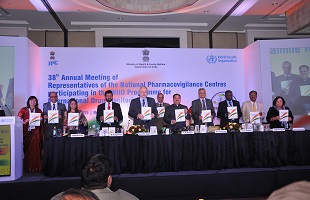Mr J.P. Nadda, Union Minister for Health & Family Welfare inaugurated the 38th Annual Meeting of Representatives of the National Pharmacovigilance Centres participating in the WHO Programme for International Drug Monitoring being held at New Delhi from 4-6 November 2015.
At the inaugural event it was announced that the Indian Pharmacopoeia Commission is in the process of becoming the first WHO Collaborating Centre for Safety of Medicines and Vaccines in the South-East Asia Region.
The meeting is hosted annually by one of the WHO Member States and acts as a platform for countries to discuss current issues and concerns in pharmacovigilance. This year, the meeting is hosted by the Indian Pharmacopoeia Commission, National Coordinating Centre- Pharmacovigilance Programme of India with active support from WHO. More than 150 international delegates from over 57 countries are attending the meeting.

In his inaugural address, the Health Minister emphasized that the success of pharmacovigilance depends on the state of art reporting, cutting edge use of information and communications technology to process and analyze information for immediate corrective measures, which needs to be supported by a highly calibrated audit process.
The Minister applauded the WHO Collaborating Centres across the globe, which serve as platforms for knowledge transfer and act as catalysts for developing the next level good pharmacovigilance practices and awareness of adverse drug reactions and their reporting.
In her message, Dr Poonam Khetrapal Singh, Regional Director, WHO South-East Asia Region said, “The meeting is timely and expected to facilitate partnerships between WHO Member States, collaborating centres of WHO, Adverse Drug Reaction monitoring centres of the Pharmacovigilance Programme of India, industry and research institutions to showcase best practices of pharmacovigilance towards ensuring safety of medicines.”
Other prominent dignitaries at the inaugural were: Mr Bhanu Pratap Sharma, Secretary, Ministry of Health & Family Welfare (MoHFW); Dr Jagdish Prasad, Director General of Health Services, MoHFW; Mr K.B. Agarwal, Additional Secretary, MoHFW; Mr K.L. Sharma, Joint Secretary, MoHFW; Dr G.N. Singh, Secretary-Cum-Scientific Director, IPC; Dr Lembit Rägo, Head of Regulation Medicines and other Health Technologies, Essential Medicines and Health Products (EMP), WHO HQ and his colleagues Dr Clive Ondari, Coordinator, Safety and Vigilance of Medicines, WHO HQ; Dr Shanthi Pal, Group Lead, Medicines Safety, Safety & Vigilance, WHO HQ and Ms Prakin Suchaxaya, Coordinator, Health Programmes, WHO Country Office for India.
Two pre-events preceded the main meeting: a workshop on the WHO ATC/DDD (Anatomical Therapeutic Chemical/ Defined Daily Dose) methodology and drug utilization research (2-3 November 2015); and “Let’s talk PV! Uppsala Monitoring Centre pre-meeting day (3 November 2015). Over the past 30 years, the network of pharmacovigilance centres has grown immensely and the annual meetings have become a significant forum for discussions on advancement made in the area of safe medicines.
For more Information, please visit: http://whopvindia2015.com/
More about Pharmacovigilance Programme of India & WHO Programme for International Drug Monitoring
Pharmacovigilance (PV) is defined as the science and activities relating to the detection, assessment, understanding and prevention of adverse effects or any other drug-related problem. The history of pharmacovigilance goes back nearly 50 years. In 1965, the 18th World Health Assembly resolution (WHA 18.42) drew attention to the need for adverse drug reaction monitoring. Further resolutions in 1966, 1967 and 1970 resulted in the WHO Programme for International Drug Monitoring (PIDM).
Initially, the WHO Programme for International Drug Monitoring (PIDM) consisted of 10 countries as its members. As of October 2015, 122 countries are full members in the programme and contribute to the WHO Global Database, VigiBase. The WHO Collaborating Centre for International Drug Monitoring, the Uppsala Monitoring Centre manages and maintains VigiBase on behalf of WHO and its Member States. There are over 11 million reports of adverse reactions in VigiBase.
The Pharmacovigilance Programme of India (PvPI) has progressed considerably in the last few years. Supported by WHO, the programme has broadened its scope of activities and influence - providing a stage for discussions and partnerships in the area of pharmacovigilance.
